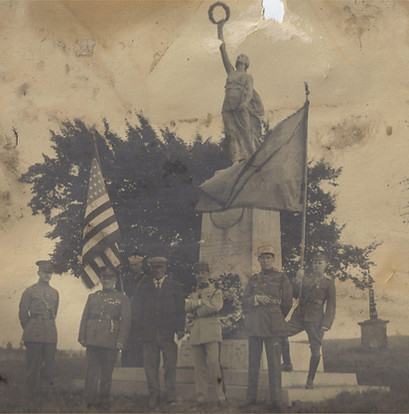Cheppy Missouri First World War Monument: The Meuse-Argonne Offensive was heavily criticized for Pershing’s use of infantry without artillery support, resulting in an unnecessarily high casualty rate. Despite being the deadliest battle in U.S. history up to that point, the Meuse-Argonne Offensive marked a turning point in the war, leading to Germany’s surrender mere months later. In commemoration of the brave sacrifice of the Missouri troops who fell in France, a memorial was erected in Cheppy in 1922. St. Louis sculptor, Nancy Coonsman, won a statewide contest to construct the memorial. Its inscription reads: “Erected by the State of Missouri, United States of America, to the memory of her sons who died in France for humanity during the Great War 1917-1918.” The monument survived WWII and remains to this day.


Left: Dedication of the Cheppy Missouri First World War Monument, James Weiss furthest to the left, 1922
Right: The Cheppy Missouri First World War Monument, 2009
Souvenirs: Collecting souvenirs is a common practice in war, stretching back to ancient times. For many American soldiers, this was their first time leaving the country. They brought back with them mementos of their service as well as trinkets and treasures from the foreign lands they traveled through. Most international objects within the museum collection were brought home by veterans of foreign wars, and World War I was no exception.
U.S. Equipment: Souvenirs are not limited to foreign memorabilia. Many soldiers returned with their own equipment from the war, be it their uniform or mess kit that accompanied them through the trenches of Europe. These mementos hold the memories which American soldiers often refused to talk about with their families back home, preserving their personal history for the future.

Occupation: As the U.S. Army marched across Europe, they left behind occupying troops to maintain control over conquered territory. These troops, some of whom remained for a year after the Armistice was signed, were often treated quite hospitably, whether out of fear or respect by the German people. One such soldier, a Missouri man named Paul Howard, recalled his time in Germany fondly, viewing the hospitality of the German people as very comforting to the occupying American troops. “Everything they had was ours, and everything we wanted we got.” Howard returned home with an impressive German pipe which drew the attention of the local news.
It was occupation which led to the creation of a unified Germany. In the early nineteenth century, Napoleon Bonaparte marched across Europe, conquering the Holy Roman Empire. His occupying French troops demonstrated to the ethnically German people their clear cultural differences, inspiring them to seek unification. Similarly, quartering British troops in the American colonies led to the foundation of our independent country. The largest portion of the museum’s international collection was acquired by occupying troops stationed around the world.



